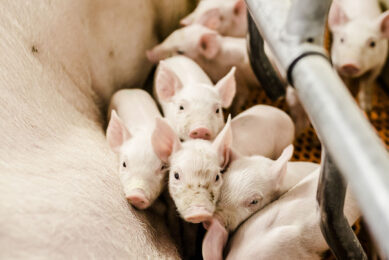Adjusting sow nutrition in key stages of transition

Improved piglet livability adds value to the swine unit. New research and the development of an advanced nutritional programme have confirmed that improved sow nutrition at key stages in the breeding cycle will help improve birth weights and piglet vitality.
The average piglet livability in Europe is 83%, ranging from 70% to 90%. It is influenced by the number of stillbirths and pre-weaning mortality within a litter. If the levels of these 2 can be reduced within a litter, then livability increases which can lead to enhanced sow performance and piglet welfare.
Larger litter sizes challenge piglet livability. More piglets can result in longer and more difficult farrowing for the sow and less litter uniformity. Small piglets in particular are more at risk of pre-weaning mortality.
Meeting the transition challenges
Helping the sow, by improving her nutrition around parturition, in the transition phase from gestation to lactation, can have a significant impact on piglet livability. This has been the focus of Cargill’s recent pig research programme and has led to the development of Livelle Transition feeding strategy. This breakthrough in sow nutrition can help the sow in supporting larger litters, from birth to weaning.
There are 3 important steps in the transition phase:
- the week before gestation,
- farrowing and
- the first week of lactation.
Sow metabolism undergoes major changes during the transition phase, marked by a negative energy balance and high oxidative stress, as shown in Figure 1. The changes are greater in larger litters and require special nutritional attention.
Figure 1 – High oxidative stress in sows around parturition: a risk for piglet livability and sow performance.

1. Start of the transition phase
The transition phase starts the week before farrowing. Sow metabolism switches from an anabolic to catabolic state, supporting a higher growth of the foetuses, preparing the sow for farrowing, colostrum production and early lactation.
2. Parturition
Farrowing should not last more than 5 hours, but it can vary greatly from one sow to another. It will be affected by the sow’s body condition and her ability to mobilise increased energy and minerals, particularly calcium.
Adequate water supply and ensuring feed intake with a diet that optimises fermentable fibre, digestible amino-acids and cation-anion balance, will help the farrowing process.
3. Lactation
Milk production starts immediately after birth and increases day by day, at a faster pace than sow feed intake. This influences the mobility of maternal body reserves. Managing and feeding the sow with precision during this period can result in a significant improvement of piglet livability.
Adding 3% to piglet livability
- Adding the aforementioned transition feeding strategy to sow diets from her entering the farrowing house until the start of lactation can boost performance in this critical period. It includes the additive Provilyt that stimulates liver function and improves sow energy at birth and in early lactation. Cargill research shows that this additive can improve piglet livability by up to 3% and reduce sow body weight loss during lactation.
- The feeding strategy also includes another additive, Proviox, and essential micronutrients. These products support sow metabolism and foetus development and provide antioxidant defences.
- Intestinal sow comfort, mineral mobilisation and the onset of early lactation is enhanced too, through a balanced formulation on fermentable fibre, electrolyte balance and digestible amino-acids.
Extensive trial work by Cargill has demonstrated the significant benefits of the transition feeding programme. Trial results show improvements in piglet birth weight of 2.7% and in piglet vitality of 2.1%, as shown in Figure 2. These improvements are equivalent to an extra 0.75 piglets or 50 kg pork meat per sow per year. The magnitude of improvement will differ based on the initial performance level of the sows.
Figure 2 – Complementary sow feed**: Effect on piglet birth weight and livability.

Dietary improvement
Dietary improvements from weaning to oestrus can also benefit piglet livability. This is a four to six day period when the sow is recovering from her lactation and preparing for oestrus.
A better diet can improve the quality of oocytes production; the starting point for a uniform quality litter.
- To help achieve this, Cargill has developed and tested Livelle Profert, a complementary feed rich in glycogenic components that stimulates reproductive hormones and supplies micronutrient essential to early embryo development.
- Trials conducted by the company using this complementary feed show increases up to 11.5% in piglet birth weight, as shown in Figure 3. In the same experiment, sows supplemented with this complementary feed had 40% fewer piglets with a birth weight less than 1 kg when compared to the control group.
Figure 3 – Positive effect of a transition feeding strategy* on birth weight and uniformity.

Conclusion
In the past decade, average litter size at birth on many units has increased by more than 30%. The subsequent livability challenge has caused the number of weaned piglets to not keep pace with this. Genetic breed selection, management and hygiene all contribute piglet livability. Using a specific nutritional strategy during the weaning to oestrus interval and during transition from gestation to lactation, helps to raise sow productivity to the next level.
Author: Marc Decoux, global swine technology leader, Cargill
 Beheer
Beheer





 WP Admin
WP Admin  Bewerk bericht
Bewerk bericht